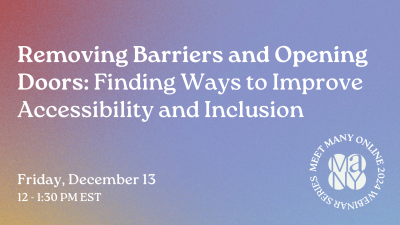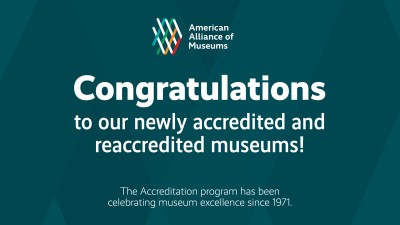
This visual Data Story is based on findings from the 2024 Annual Survey of Museum-Goers, a national survey of American museum visitors from AAM and Wilkening Consulting. Every year, the survey partners with individual museums to research their audiences and yield insights about their behaviors and preferences, both on an institutional and national level. Interested in joining the 2025 edition on the themes of repeat visitation, social connection, and community trust and responsibility? Sign up by February 28, 2025, for a special early bird rate.

Over the past five years, visitation patterns at museums have changed dramatically. We all know that the COVID-19 pandemic devastated in-person visitation, but for the most part, people have returned to museums.
Skip over related stories to continue reading articleFrequency of museum visitation, however, has not yet returned to pre-pandemic norms, and the biggest gaps are with repeat visitation.
To learn more, we made “repeat visitation” a theme of the 2024 Annual Survey of Museum-Goers.
Overall, respondents shared with us that the reasons they make return visits to specific museums are the same reasons they visit museums in the first place: for learning, respite, fun, and to spend time with family or friends.
A pithy way of putting it is: people visit museums to see your cool stuff, in the company of people they care about.
That said, there were a number of things that came up that either discouraged return visits or are opportunities for deeper engagement.
In this Data Story, we’ll cover four briefly. Upcoming Data Stories will focus on three other areas that merit more rigorous attention: cost, community, and staff interactions.
1. Novelty and Interest
Unsurprisingly, the top reason people gave for making a return visit was to “see something new.” We tracked this response over two different questions and found:
- 1/4 of respondents chose the “something new” response in both questions
- Just under 1/2 chose it in one or the other question
- And 30% did not choose it in either question
Respondents who most wanted to see something new were more likely to explicitly want exhibitions to change more often and a greater variety and depth of programming.
They also, however, visit museums more frequently and are even more motivated than other respondents to visit for their own learning, interests, and curiosity. Overall they are simply more deeply engaged with museums.
Meanwhile, those who did not select seeing something new at all were generally more negative about, and less engaged with, museums. They visited less frequently as well.
This suggests that the demand for new exhibitions and experiences is coming from the people who are already our biggest fans. In fact, this demand for new is likely more of an endorsement of our work than a criticism. We delight them regularly with what we do, so of course they want more!
Museums can’t change exhibitions every month to meet this need. But knowing that these audiences are making the request out of their already-high levels of delight with museums means we can instead consider more nimble ways of helping this audience view exhibitions through different lenses on each visit, or give them opportunities to go deep in unexpected (and low-cost) ways. Additionally, it also means that a bit of education about museum operations (and the high costs for changing exhibitions in particular) may also go a long way for this audience. In fact, they may find that interesting in and of itself.
2. Health Concerns
While the COVID-19 pandemic did bring greater awareness of viruses (including flu and RSV), for the most part, very few museum-goers said health concerns were keeping them from museums: only 5%.
The 5% with health concerns skews older: over three-quarters of these respondents are over the age of 60.
Interestingly, the health-concerned are much more likely than other respondents to say they were engaging with museums virtually. That said, it is only about a quarter of the health-concerned who are reaching out virtually–a relatively small percentage of people.
But the population of seniors, many of whom have health constraints, is growing. When resources allow, developing a digital strategy for serving that audience not only would extend the work of museums, but it would also support better health and wellbeing among our oldest stakeholders.
3. Crowds
While most museum-goers are fairly unconcerned about crowds, there were two segments of visitors who were much more likely to express concerns:
- Young adults (under 40) without children
- Families with children, especially those 5 and younger
These respondents were two to three times more likely than older respondents to say they dislike crowds. And if you imagine keeping track of young children while juggling a stroller, it isn’t hard to see why families in particular are more likely to want to avoid crowds.
We’re not sure why young adults without children are also more crowd adverse, but we think it may be because they are the most likely segment of museum-goers to be looking for respite in museums–something a crowded room would preclude. Interestingly, the segment of the population least likely to be worried about crowds was adults over the age of 60 (these older adults are less likely to seek respite from museums as well).
If your museum does have busy times, consider sharing more proactively, or incentivizing, your less-busy times so that those who dislike crowds can choose quieter times to visit.
4. The Breakup Lines
We’ve talked about “breakup lines” before, when exploring membership trends. Those lines that suggest it’s not you…it’s me…(but it’s really you).
They apply to museum visitation as well. Nearly 20% of museum-goers shared that the reason they didn’t visit museums more frequently is because they were “too busy” or just “didn’t think about it.”
And those are breakup lines, because if museum content was compelling enough, they would likely find time and think about it. They would make the effort because it would be worth it.
These respondents do care about museums (after all, they do visit and took time to share their thoughts in a survey!), but the relationship just isn’t working. Their lower levels of museum visitation indicate they are drifting away.
Why? Well, we’re not really sure. Overall, these respondents do seem to want more from museums. More immersive experiences. A greater variety of things to do when visiting. More events and programs. Broader community outreach and community-building. Respondents who gave these reasons were also somewhat more likely to be young adults without children.
We don’t really have much else to go on for now, but given that one in five respondents gave these answers, we’re putting this in the “needs follow-up research” category.
Results for these four areas give us some greater insight into why people don’t visit more frequently, but they also raise more questions.
- How can we create a sense of change for our most frequent visitors without draining significant resources?
- What are our opportunities for serving the health and wellbeing needs of homebound seniors?
- And what additional research do we need to field with younger adults to better understand how we can fit more meaningfully into their busy lives?
Keep in mind as well that these four areas were not the only ones that came up. Cost, community, and staff interactions also had significant effects on museum visitation rates. We’ll consider those individually over the next few Data Stories. Stay tuned.
Annual Survey of Museum-Goers Data Stories are created by Wilkening Consulting on behalf of the American Alliance of Museums. Sources include:
• 2024 Annual Survey of Museum-Goers, n = 90,178; 202 museums participating
• 2024 Broader Population Sampling, n = 2,154
• 2017 – 2023 Annual Surveys of Museum-Goers
*Data Stories share research about both frequent museum-goers (typically visit multiple museums each year) and the broader population (including casual, sporadic, and non-visitors to museums).
More Data Stories can be found at wilkeningconsulting.com/data-stories









Comments